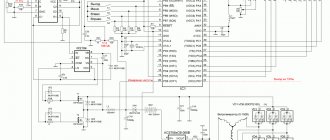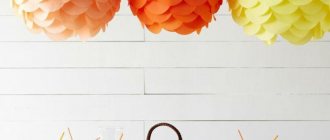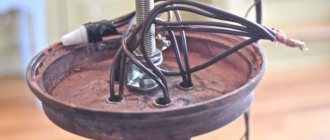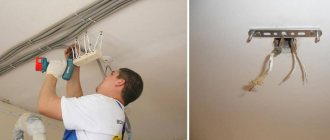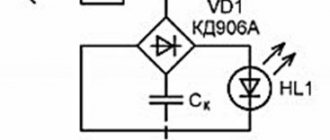- Interesting idea for a chandelier made from plastic spoons
- Chandelier made of plastic bottles in the form of leaves
- Chandelier with paper butterflies
- Fabric chandelier
- Lamp made of threads and a balloon
- Wine bottle chandelier
- Laserdisc chandelier idea
- Shabby chic chandelier
- 90 photos of DIY chandelier ideas
A chandelier in a room is not only a lighting fixture. Without exaggeration, we can say that it is the main decoration of the room. Handmade items are considered especially valuable. This allows us to highlight the special taste of the owners of the home, as well as their extraordinary and creative mind. Of course, this type of work is quite complex and requires increased concentration. But at the same time, when creating decorations for your home, you can find many interesting and extraordinary solutions in it!
This article presents some ideas for decorating a chandelier with your own hands, as well as instructions for them. Everything is written so simply and clearly that anyone can do it at home.
In order to make a chandelier, sometimes the most unusual materials are used. For example, everyone is already familiar with glass or wood, plastic, and so on. But sometimes, when you want something completely “unusual,” wooden skewers, glass wine bottles, jars, all kinds of tree branches, cardboard, and even straw come into play. You need to choose depending on the idea of the creator and the wishes of the apartment owners. You also need to take into account the general interior of the room where the finished product is supposed to be placed.
Interesting idea for a chandelier made from plastic spoons
Plastic spoons for disposable meals are one of the simplest and most easily available materials for creating a chandelier for a room. Their advantages are low price, a variety of colors, and such material will last for quite a long time. To create such an extraordinary chandelier, you will need a minimum of investments, both physical and material.
Crafts from waste materials: original ideas
DIY salt dough figurines: instructions, photo ideas
Materials:
- empty drinking water bottle, 5 liters;
- plastic spoons (their number depends on the size of the bottle);
- glue for plastic;
- an old chandelier (or rather, a socket from it);
- sharpened knife.
Process of creation:
- First you need to prepare a plastic bottle for subsequent steps. Remove the label in advance, cut off the bottom, dry well.
- Then you need to remove the plastic spoons from the packaging and carefully cut off the unnecessary handles with a knife, leaving about 2-3 centimeters above the level of the “scoop”.
- You need to glue the scoop blanks to the base of the bottle. Apply a large amount of glue to the remaining “tail” and press it to the surface (with the convex side of the spoon facing out). It is necessary to cover the entire bottle in a circle until the entire perimeter is occupied by the plastic. It is advisable to arrange them in a checkerboard pattern and slightly move them together. This will leave fewer “free spots”.
- You need to remove the cartridge from the old unnecessary chandelier, and then place it in an already glued and dried bottle and fix it to the frame.
- A decorative bowl can also be made from plastic and glued around the neck of the eggplant.
- Install and connect the chandelier, check its operation.
Note! The option of decorative painting or painting of spoons in absolutely any color is possible. Thus, your product will look even more beautiful and more original!
Chandelier made of plastic bottles in the form of leaves
Another unusual option in the interior would be a chandelier made in the shape of leaves. It is created from simple plastic bottles, the variety of colors of which allows you to work in the most unusual colors and embody the most daring ideas.
Process of creation:
- Cut plastic bottles into blanks shaped like future leaves.
- For each workpiece, the sheet shape is finally fixed.
- Using a soldering iron with a thick tip and a one-sided bevel, you need to slightly fuse the sections of each leaf in order to give the future product the greatest effect.
- In the same way, using a soldering iron, you need to give the workpieces a sheet structure. You need to act extremely carefully and accurately, because you can easily make a hole in the plastic. Such a leaf with outlined veins and slightly fused edges will look complete.
- Using a hot needle, you need to melt several holes at the “leg” of each leaf in order to attach them.
- Using thin wire, form branches and screw them to a steel wire frame.
It would also be a great idea to make a new chandelier in the form of a lampshade for a floor lamp or a table lamp. Thus, it will be a great addition to the previous product!
Chandelier with paper butterflies
The most common product option is a chandelier with butterflies. And this is not without reason. Let's start with the fact that this option looks luxurious and expensive, and secondly, its production does not require any special physical costs. Thus, even a child can participate in creating a chandelier.
Process of creation:
- It is based on either an old chandelier or a similar frame. If you don’t have one, then you can take the simplest wooden or metal rim. If such material is not available, then, as an option, you can take thick wire and make about 2-3 skeins, so that a circle is formed.
- Cut out butterflies from paper according to the template. You need to take the butterfly template and adjust it to the desired size. The option also looks very unusual when butterflies of several sizes are located on the chandelier (again, depending on desire). Transfer the outlines onto paper and carefully cut out, preferably with a sharpened stationery knife, or small, non-rounded scissors. For the templates themselves, it is better to use a material that is dense, does not become very dirty and does not attract dust. For example, velvet paper is very poorly suited for the product, because in the future you will need to vacuum the chandelier quite often.
- Take a nylon thread or transparent fishing line and attach the butterflies to it. There are two types of fastening: either piercing the bodies of the butterflies, or gluing them with silicone glue.
- Next, we attach the threads with butterflies to the base of the frame and decorate it.
- You can also try a fun variation by making a wire ball! As a basis, you should take a pendant from a chandelier and place several butterfly templates on it using a glue gun.
New life for old cans
It's time to experiment with glass jars. Let us immediately warn you that we need jars with screw caps.
Prepare the following materials:
- 5 cans
- suspension cords – 5 pcs. (can be bought at IKEA)
- soft glow bulbs – 5 pcs.
- drill
New life for glass
Let's start work.
- Remove the lids from the cans and on the back side draw a circle in the middle equal to the diameter of the cartridge. To avoid mistakes, simply remove the screw cap from the cartridge and attach it to the lid. Outline its internal hole and get the perfect circle size.
- Using a drill, drill holes in the drawn circle, placing them as close to each other as possible.
- Gently press out the drilled center.
- Insert the cartridge into the resulting hole and secure with a plug.
- Having done this operation with all the cans, collect the hanging cords into a vertical garland.
Cascading chandelier made of jars
Paper lampshades
Using cardboard
Fabric chandelier
This chandelier is also based on a frame. As in the previous version, either old metal frames or thick wire are suitable for its manufacture.
After you have pre-prepared the base, start cutting out the fabric from which the lampshade will be made in the future. How long the finished product will be depends on your desire, but it is worth considering that the width of the fabric must be the same as the diameter of the frame! Once you finish the pattern, you need to do a fitting.
Another nuance is that the top of the fabric will need to be sewn directly on the frame, which means that it (the frame) must be solid. Otherwise, if it is possible to thread it directly into the fabric, then you should first fold the top edge of the pattern and stitch it, and then iron it. Then we sew a seam on the side of the product.
Foam letters: production, methods of decoration, 69 photo ideas
How to make a key holder with your own hands: step-by-step instructions, photo ideas
To prevent the lampshade from losing its shape, you should pay due attention to the material. If the fabric is too light, “airy,” then the bottom of the product should be weighted. You can use cardboard or fishing line for this.
Carefully sewn fringe, lace or braid will look just as beautiful. But do not “overload” the product! The process of creating a fabric chandelier is similar to making a lace chandelier. So you can safely experiment with the materials that are placed on the frame.
Lamp made of threads and a balloon
Materials:
- dense threads, such as wool, cotton, or jute rope - at least 1 meter;
- cartridge;
- petrolatum;
- PVA glue;
- a brush for applying glue and Vaseline (it is advisable that the brush does not fade);
- 1 or 2 pieces of balloons (the first for working with it, and the second for checking the finished product, if desired);
Process of creation:
- Inflate the balloon to a certain size and secure it. Remember that the finished work will exactly follow the outline of the ball! Using a marker, draw a couple of circles at the top and bottom in order to determine the boundaries of thread winding.
- Using a brush, coat the entire perimeter of the ball with Vaseline.
- Pour PVA into a plastic container and thoroughly process the threads with it (It is not advisable to apply glue to the entire length of the threads at once! Process them as you wind them around the ball!).
- Taking into account the boundaries that you drew with a marker, wind the threads around the ball. Do not forget that the future appearance of the product depends on the density with which you wind it.
- After wrapping, you need to leave the product for a day until it is completely dry; After complete drying, you need to burst the ball and remove it through the holes.
- Cut a spot in the top and insert the cartridge.
- To be completely sure that the product is strong, you can insert a balloon into it and inflate it. In a similar way, you can check the flexibility and reliability of the lampshade.
Alternatively, you can paint the structure with spray can or acrylic paint, and attach all kinds of decorative decorations to it, such as butterflies, artificial flowers or beads. Also, a great idea would be to arrange several balls in the form of a bunch of grapes and fasten them together.
Wine bottle chandelier
This version of the chandelier is a little more complex than the previous ones. Making a chandelier this way is quite difficult; the manufacturing process will require care and attention. However, you will like the result!
Materials:
- wine bottle;
- glass cutter;
- sandpaper for sanding edges;
- cartridge;
- electrical wire;
- metal or wooden frame, rim.
Process of creation:
- First you need to prepare the bottle itself for further manipulations with it. The first step is to draw a straight line around the perimeter at the level you need. This is required in order to cut off the bottom of the bottle using a glass cutter;
- To avoid cutting yourself on the glass, you need to sand the sharp edges with sandpaper;
- Pull the wire through the neck of the bottle and then connect the socket;
- Attach the bottle to the frame.
You can also decorate the bottle with all sorts of decorative items, or leave it in its original form. In any case, it will look original and impressive.
The number of products on the frame depends on your desire. You can either leave one bottle or secure four or more bottles at once.
Materials
In the manufacture of lighting devices, the following are most often used:
- Brass. Suitable for structures located inside the house.
- Iron. Used in the manufacture of frames and bases for lamps.
- Cast iron. Most often used for making street lamps.
Copper and bronze are also sometimes used. These alloys are easy to process and have an attractive appearance.
Lantern (Photo: pixabay.com)
Laserdisc chandelier idea
This idea is great for those who have a large number of laser discs left in the house, but don’t dare throw them away. It’s worth noting right away that manufacturing options and the result can be very different. It all depends on your imagination and creativity!
Materials:
- two round wooden planks of different thicknesses, and which are slightly larger in diameter than the disks;
- racks made of metal or wood;
- Fluorescent Lamp;
- magnetic switch;
- disks.
Process of creation:
- Make a hole in a thicker board and install a starter with a switch in it.
- Then connect it all to the lamp.
- String disks onto the lamp.
- Place the stands around the discs and secure the top.
Weaving from rubber bands: overview of methods, step-by-step master class
How to make shelves for flowers with your own hands: ideas, types, instructions
The finished product will delight its owners for a long time, and it does not require special care. It is not advisable to place this type of chandelier in a child’s room so that the child cannot harm himself (only if the chandelier hangs out of reach).
Manufacturing technologies
In the manufacture of shades for chandeliers at home, different techniques are used. Many of them are already familiar to needlewomen and craftswomen, such as knitting, weaving, sewing.
As well as lesser-known technologies and their combinations, it will be possible to create an exclusive item from inexpensive materials. Things made carefully, with soul, with your own hands, bring warmth and comfort to the house.
Shabby chic chandelier
To create spectacular lighting in a room, you can also make a chandelier from fabric or beads. The result will be a kind of candelabra or lampshade in the “shabby chic” style.
Materials:
- a ready-made metal or wooden frame (or it can be made from an old hoop, garden basket, thick wire);
- socket and lamp;
- chains and threads for decoration;
- all kinds of beads and seed beads.
Working on such a lampshade is not difficult, but it is a very painstaking task. Such chandeliers usually consist of two or three levels of rings, which are located on top of each other. It all depends on the size of the chosen bases. If you take rings of the same diameter, the finished product will be made in the “modern” style.
One of the important points is that before you start decorating the chandelier, you need to paint and wrap the frames with decorative materials!
The approximate consumption of beads is:
- For the lower part of the lampshade - 16 mm beads, about 15-17 pieces per thread;
- For the upper part of the lampshade - 12 mm beads, about 35 pieces per thread.
Naturally, when stringing beads on a thread, you can increase or decrease their number or the degree of thread tension. But it is still advisable to stock up on materials in excess of the norm.
The essence of the work is to hang threads with beads in a “waterfall” or “cascade” so that they flow downward along the structure.
In order to create the effect of “muting” the light, you can sheathe the frame with thick fabric.
A DIY chandelier will definitely add a fresh touch, originality and beauty to your interior. You will immediately notice how the room will sparkle with new colors, and your guests will sincerely admire your creativity, hard work and original taste!
Difficulties must be overcome
To make a chandelier, you need to think through everything. The main thing is not to spoil the materials. The first step to creating a masterpiece is to familiarize yourself with the presented master classes, study the photo and video instructions, and only then get started.
This order of work will allow you to understand the sequence of your thoughts, and you will gain skills in working with certain materials. Perhaps while watching you will come up with a unique idea.
Although the work is not difficult, it is painstaking, so no matter what material you take, it is better to do it slowly. The created lamp will serve you for many years. Follow safety rules when working with electrical appliances . Use only high-quality insulating and connecting materials.
Before creating a lamp, first sketch its final result - this develops spatial thinking and allows you to see the subtleties that you will have to deal with. After following the instructions you will not have any difficulties.
Recommended viewing: Butterfly waterfall.
